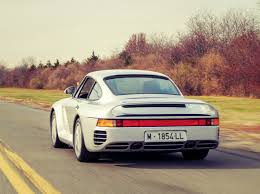Introduced during the 1983 IAA (Frankfurt International Auto Show), this beast called the 959 was intended to be a homologation special for participation into the FIA Group B racing (already defunct since 1986 due to being ungodly dangerously fast) with at least 200 examples of road going version to be built. Nevertheless, anyone lucky enough to own this marvelous piece of machinery will have the liberty to stretch its legs in their grandpa's favourite twisties, or show off Senna-esque 'win at all cost' on god forbid the most Frankestein monster of a race track (Nordschleife we are looking at you).
This car is everything that Porsche can do to augment the taste, the flight of fancy that every 911 owners could dream of. Yes folks, the 959 is basically a 911 with some bonkers going on under the skin, making it arguably Porsche's first true supercar, outfitted with state-of-the-art niceties for its time (mind you, this beast was produced in the late 80s).
 |
| Source: silodrome.com |
The source of 'oomph' lies at the very rear extremity of this beast. What is not to like about the crazy 2.85 litre sequential turbo flat six with its twin cooling system. Yep, this engine is both water-cooled and air-cooled, with water cooling the cylinder head and the turbochargers, and air cooling the cylinder block and crankcase. Ramming air into the cylinders are taken care of by two turbos, one small turbo and one large turbo for consistent boost across the rev range for more smiles per miles. All in all, 450 ponies worth of fun.
All those powers are channeled to a six speed manual transmission and permanent all-wheel drive with driver-selectable driving programs to ensure all those insane powers will keep you from flying off the cliff.
As always in performance realm, going on a diet is the holy grail in translating those huge powers into whatever performance figures that anoraks cherish. The doors and hood for instance, were made of aluminium and the rest of the body was Kevlar-reinforced fibreglass.
The 959 was offered in two trims: sports and comfort. Choose the sports trim, you will have to make do without air-conditioning, power windows and seats, back seats and adjustable ride height control in the name of weight savings. Choose the comfort trim, you have the aforementioned niceties equipped but at the expense of increase weight, but if go-fast is not your thing then this is the trim to choose.
 |
| Source: auto.howstuffworks.com |
To those who own a 911 or have 911 as their 'cover girl', the 959 is an incredible boost for the 911 experience, with the added performance to put the standard 911 to shame. All in all, the 959 is not a wannabe 911 with 911 cosmetic enhancement per se, but a 911 that will make you clamour for it.






